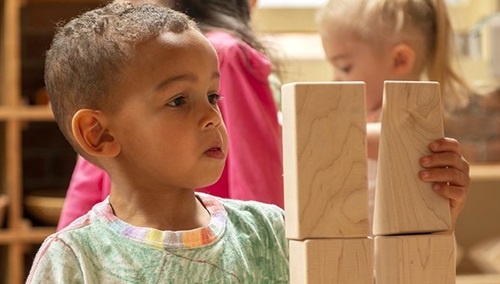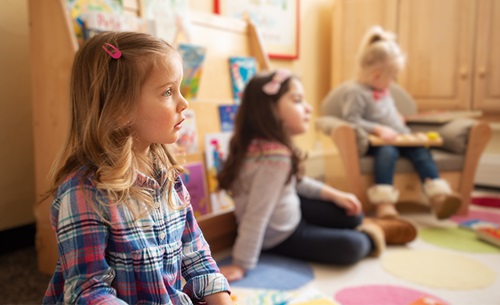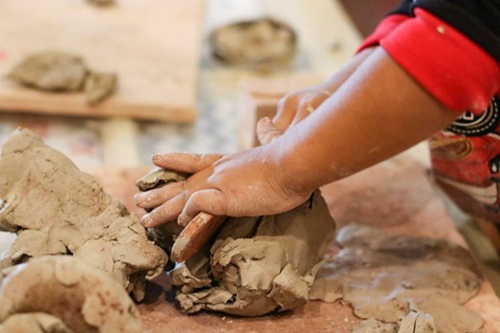Play: A Child’s Natural Mechanism for Coping
| February 2021The shocking events dominating the news over the last months have been overwhelming, even for adults. Although caregivers may try and shield children from frightening headlines, it is impossible to protect them completely. How can we help children to deal with current crises in an emotionally healthy way? Maybe being aware of the neuropsychology driving a child’s behavior and development will give us a better understanding of what is at stake.
While children may not watch the news directly, they are still constantly on the periphery of current events. They may see and overhear some news repeated and sense something is different, something concerning. They pick up cues, tensions, and emotions from the adults in their lives. If given the opportunity, they will use their play as a way to make sense of it all. This gives them control and power over happenings they don’t fully understand.
The Role of Creative and Dramatic Play
We all remember the news coverage, in years past, repeatedly showing the Twin Towers coming down on September 11 or the repetitious footage of the 2008 oil spill in the gulf. Just as these images are seared in our memories, the intense daily coverage of the COVID-19 pandemic and the shocking events that seem to take place daily in our nation, will shape the lives of the next generation.
The summer of the oil spill in the Gulf (2008) I remember being at a local lake and seeing many of the children building their usual sand castles. Over and over again I heard them shout; “Spill! Oil spill!”, and other scenarios reflecting that current issue in their play. Similarly, after September 11, many teachers reported children reenacting towers collapsing in their block play. Just as adults have unconscious coping mechanisms for dealing with trauma, children naturally use creative and imaginary play to cope.
We in the early childhood field must know, value, and support the role of play both in learning, and in emotional health. This is not just limited to young children, older elementary children need play just as much. Are they getting the time and space needed to experience the power of play? As we also know, executive functions continue to develop as children grow, creating and following games with rules, arguing and problem-solving, holding up and onto friendships, and finally, maturing into functioning adults. It feels like too many are being denied the opportunities to develop and exercise these skills today.
Creative play can exhibit itself in a variety of ways depending on the age of the child. For an older, literate child the creativity may be expressed in writing or drawing. I was reminded of that this year when my 8 year old granddaughter (Emme) created an illustrated story book as an end of the year/retirement present for her 2nd grade teacher.
In the year 2079 the second grade class was talking about the Covi Monster of 2020. One of the kids said; “I can’t believe people really believed that silly myth back then!” Yeah, the others chimed in. Then Mrs. Morgan said; “We are going on a field trip today to the Myth Museum maybe they will have an exhibit of the Covi Monster we can see for ourselves.”
At the museum, the Covi monster escapes the display case and chases the kids. Eventually the teacher emerges as the hero, fighting off the monster!
The Role of Outdoor and Risky Play
According to Peter Gray; “Over the past 60 years we have witnessed, in our culture, a continuous, gradual, but ultimately dramatic decline in children’s opportunities to play freely, without adult control, and especially in their opportunities to play in risky ways. Over the same 60 years we have also witnessed a continuous, gradual, but ultimately dramatic increase in all sorts of childhood mental disorders, especially emotional disorders.”
Neuropsychology—the study of how the brain affects behaviors—offers some solid proof as to how play gives children the power and control they need to overcome adverse situations. “Kids brains work better when they have a sense of agency,” writes William Stixrud. “When they perceive that they have control, their prefrontal cortex—the seat of executive function—regulates the rest of the brain.” Conversely, when children feel like something is threatening or out of their control, the amygdala—the brain’s emotional “fight and flight” center—takes over and they are no longer able to think clearly.
In Rusty Keeler’s, newest book, Adventures in Risky Play, he discusses the vital role outdoor learning can play in giving children a sense of control as they master appropriate risks. He first explains that assuring children’s safety from true harm must be taken as a given, but then goes on to write: “opportunities for measured risk-taking can create more able-bodied and self-assured children who will be better equipped to live safer lives in the long run than if we overly protect them to be safe in the momentary short term.”
Teachers and parents play a key role in outdoor play. Supporting children means knowing when to stay near, but out of the play, and when intervention is necessary. We must assess and address our own biases and our risk tolerance.
What We Can Do
In order to hold onto what brings joy into our work with children, especially through challenging times, we must develop honest, authentic relationships with the children and their families. We cannot prescribe in September what the year will turn out to be like. The circumstances of the world can change dramatically during our time together. But we can build a safe and open haven where we engage with children and families about our shared emotions and humanity. This is not in the text books but it is a MUST for today. Magda Gerber once said something like; “It is absurd! We are preparing children today, based on our own past for a future we know nothing about.” In a similar way, the singer Tom Hunter penned his thoughts on the subject in his memorable song:
How can we prepare our children
For a world we cannot yet see?
I think we work hard so they can become
As human as they can be.
For children, this “becoming human” is best explored and developed through play. In any time of history, and in particular, in upsetting times, children need to be given the time and space to work through their fears and anxieties through the context of play. And in order to become more resilient to challenges yet to come, children need to be given the time and space for outdoor, risky play as well.
I have high hopes for the rebuilding we are all exploring in early childhood education in this country. Our leaders are holding a spotlight up to the need for greater public support, re-working the funding streams so that we can re-open but rebuild our programs with a new awareness of the systemic changes that need to happen for children to thrive. I want to acknowledge the work of my colleagues who are asking us to reimagine our work (ROW) and be BRAVE enough to address our own bias to truly support the children and families. I believe it will have to come from the bottom up. Myself, my classroom, my center, my city, my state.
References:
Gray, Peter, Ph.D April 2014. “Risky Play: Why Children Love It and Need It” Psychology Today. https://www.psychologytoday.com/us/blog/freedom-learn/201404/risky-play-why-children-love-it-and-need-it
Keeler, Rusty. Adventures in Risky Play: What Is Your Yes? Lincoln, NE: Exchange Press. 2020.
Stixrud, William and Ned Johnson. March 31, 2020. “Children Need a Sense of Control” Parents League of New York. https://www.parentsleague.org/blog/children-need-sense-control












